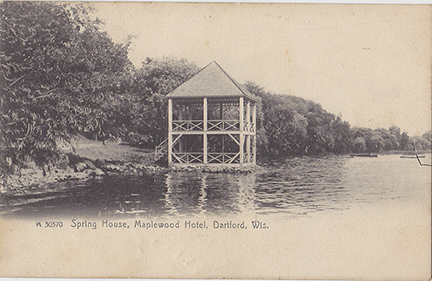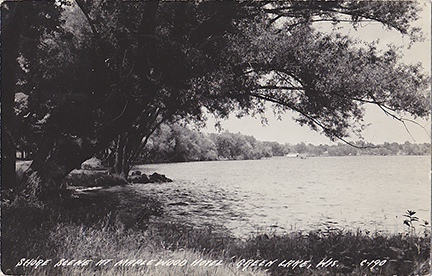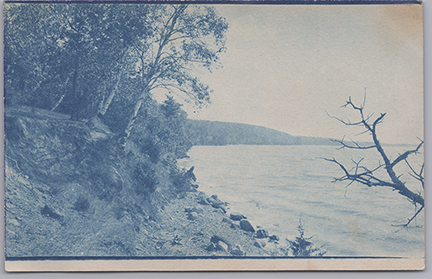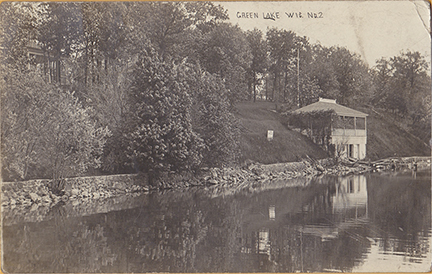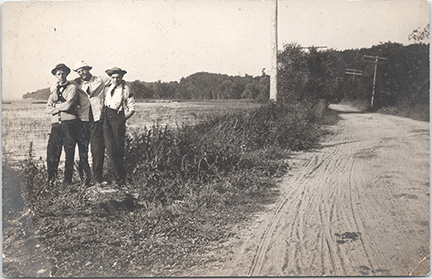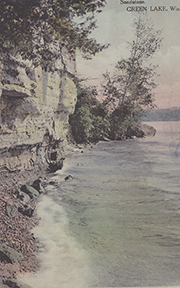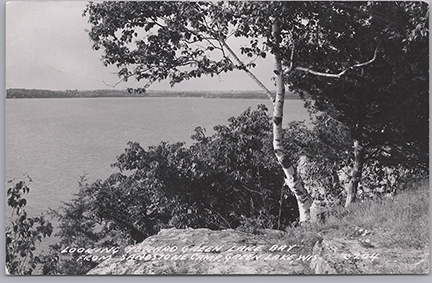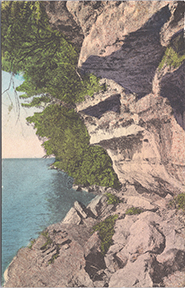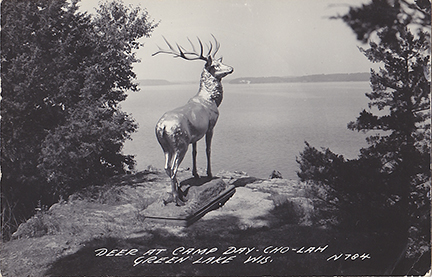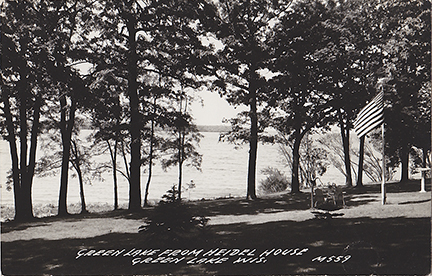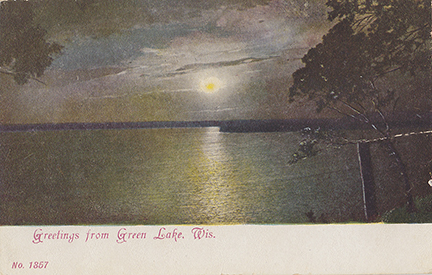Lake Views
Here is a really nice early view of Green Lake. It looks like the J Norton, or possibly the Queen of the Lake, is waiting at the Oakwood dock to pick up passengers for a tour around the lake. There are a lot of really cool views of the lake. I will be adding more to this section as I get time.
Table of Contents
Click on any image to view a detailed view of the card.
Dartford Bay Area
The city of Green Lake was originally called Dartford, named after Anson Dart, who was the first settler to build in the area. The city name was changed in 1907. The Norton family, Captain Pierce and The Brooks Brothers all had boat works and marinas here.
Maplewood & Sherwood Forest Shoreline Area
The Sherwood Forest Resort was built in 1872. Victor Kutchin first started taking in guests at his family home on the Sherwood farm in 1891 along the west shore of Dartford Bay. The Maplewood Hotel was a large presence in this area. The main structure in many of these cards is the spring house that protected the Techura Spring, that was the early source of water for the Maplewood Hotel.
The Hickories is located just to the west of the Sherwood Forest property. Just west of the Hickories is a piece of property called Thousand Oaks. It was bought by Alf Reed and several Ripon families had cottages there.
Pictures of the Maplewood and Sherwood Hotels will be located at the hotel page (Coming Soon)
Lawsonia / Pigeon Cove area
Jessie Lawson’s most ambitious and most expensive project on the Lawson estate was redeveloping Pigeon Cove. This took place over two years, from 1903 to 1904. The McKissac Company out of Chicago was hired to engineer the massive sea wall project. The wall was said to cost over $35,000-a lot of money in the early 1900’s. Draining the swamp, deepening the bay and enlarging the island cost another $50,000.
Just Do It Jessie’s Way! By Kathleen Kleinpaste p38-40
There will be a whole section devoted to the Lawson estate and GLCC.
Norwegian Bay / Sugarloaf
The most prominent feature of Norwegian bay is the spit of land called Sugarloaf. At one time ancient Winnebago Indian tribes lived and roamed there. You can still see signs of the large Indian effigy mounds. Old Captain Pierce once owned a farm there. The Norton family used the island as a picnic spot to serve their famous fish fries and fish chowder. In the late 1880’s Charles C. Peacock summered at the Oakwood with his family. He would board the Queen of the Lake at the Oakwood dock and cruise the shore of Green Lake taking in the beauty of this grand lake. He enjoyed Sugarloaf and the abandoned farm on the site and decided that would be a great place for his family. He originally bought ten and a half acres for his family. The original farmhouse was remodeled numerous times and lasted until the 2020’s when the original house was torn down and new, much larges residences were built there.
A small spring fed creek runs into Norwegian Bay and brings with it a fine tan sand that has filled the end of the bay. Today the sandy shoreline along the north shore is a popular area for swimmers, and crowds of people can be seen there all summer. One of the postcards that is shown here is a view of the bullrushes that still make an appearance there today.
Heritage History of GL p232
GL Memories p192
West End / Green Lake Terrace / Black Bird Point
This section of the lake includes images from the Green Lake Terrace area, around Reilly’s Pub, past Governor Dodge Park up to Blackbird Point. At one time Blackbird Point was an island. Over time a road was built, and Blackbird Bay became a swamp.
This is an interesting view. At first look I thought that this was the inlet road (Cty A). However the inlet road was not built until 1925 and this card was postmarked 1909. I think this view is just west of Governor Dodge park, east of the bridge.
Southwest Shore / Tichora to Sandstone
This area will include photos along the south shore from the White Sails area, past Tichora and Dickenson’s Bay up to Woods Bay and the Sandstone Area. I have created a separate section for views of the Lucus Stag, as there are so many views of this majestic statue.
The Stag on Sandstone Point
Mr. William Lucas acquired 640 acres from the Horner family in 1872. He proceeded to build a beautiful home that he called “Cote Brilliante.” The House was a large two-story square structure with verandas and pillars stretching around on three sides. The drive leading to the house was lined with tall hard maple trees. There is a plaque at the intersection of Horner Drive & Sandstone Ave that says “This Row of Trees Planted by William Lucas in 1872.”
When the house was finished, Mr. Lucas had a large metal statue of a stag made especially for him in St. Louis. The Stag was placed along the bluff that could be seen all around the lake. This statue lasted until the 1960’s when vandals pushed the statue into the water. As a side note, Mr. Lucas was the person who introduced lake trout to Big Green Lake in 1886. Check out the Fish & Fishing page for more about the lake trout on Big Green (coming soon).
The house was abandoned and burned to the ground in 1910. Sandstone Camp for girls was started here in 1911.
For pictures of the Sandstone Camp and Day-Cho-Lah Camp check out the Childrens Camp Page.
Heiple Heritage History p205
Here are a few of the postcards that show the stag throughout the years. The last card is a view from the lake that show the bright bronze stature. The card is postmarked 1966, shortly before the statue was pushed into the lake by vandals.
Southeast Shore / Horner's Landing and Spring Grove Area
Southeast Shore / Horner’s Landing and Spring Grove Area
This section will include images of the south shore from Horner’s Landing to the Pilgrim Center.
Horner’s Landing was the first public access landing to any lake in the Midwest. The land for Horner Road and landing was donated by John Scott Horner. John Scott Horner was the first Governor of the Michigan Territories, an area that included land from Detroit to the Rocky Mountains. Mr. Horner was one of the founders of the city of Ripon. William Lucus would marry Mr. Horner’s daughter and purchase land from his father-in-law that would become “Cote Brilliante,” his grand estate on Sandstone Bluff.
The Girls Friendly Society Holiday House, Spring Grove Hotel and the Pilgrim Center were all located in this area.
East End / Inlet and County A
The inlet road was built in 1926 to 1926. Before that time, you had to take Spaulding Hill Road to Skunk Hollow Road to get around the east end of the lake. The Crook Family owned the farm on the south shore, east of the Pilgrim Center. They donated land for the building of the inlet road. Carvers Restaurant was located north of the inlet in an area that was called Terrace Beach. In 1898 O.E. Meyer, the owner of Sunny Side, built the Terrace Casino nightclub in this area. It operated successfully for just over a year when a mysterious fire burned it to the ground,
Heiple Heritage History p382 & p237
North Shore / Pleasant Point to Oakwood
Many of the early estates and resorts were built along the north shore in this area. The land that would become Pleasant Point Hotel was purchased in 1879 by two brothers, James & George Ross of Chicago. A large resort building was built in 1880 followed later by the addition of 7 cottages. At one time the Pleasant Point Hotel could accommodate 200 guests along 900 feet of the lake. Pleasant Point Hotel burned to the ground in 1928 and was not rebuilt.
On the west end of Illinois Avenue David Greenway built the first summer resort west of the Niagara Falls in 1867. The Oakwood Resort lasted until 1929, when the large main building was razed. At that time the property was subdivided into small lots and some of the cottages that surrounded the main building were moved to Lake Street.
Heiple Heritage History p115 & p127
Assorted Lake Views
Throughout the years, many companies produced postcards to illustrate the beauty of Green Lake and promote tourism at the lake. Most of these cards show specific areas, but some are just nice views of the lake. Not all of these cards are actually Green Lake, some are stock cards that are labeled Green Lake.












